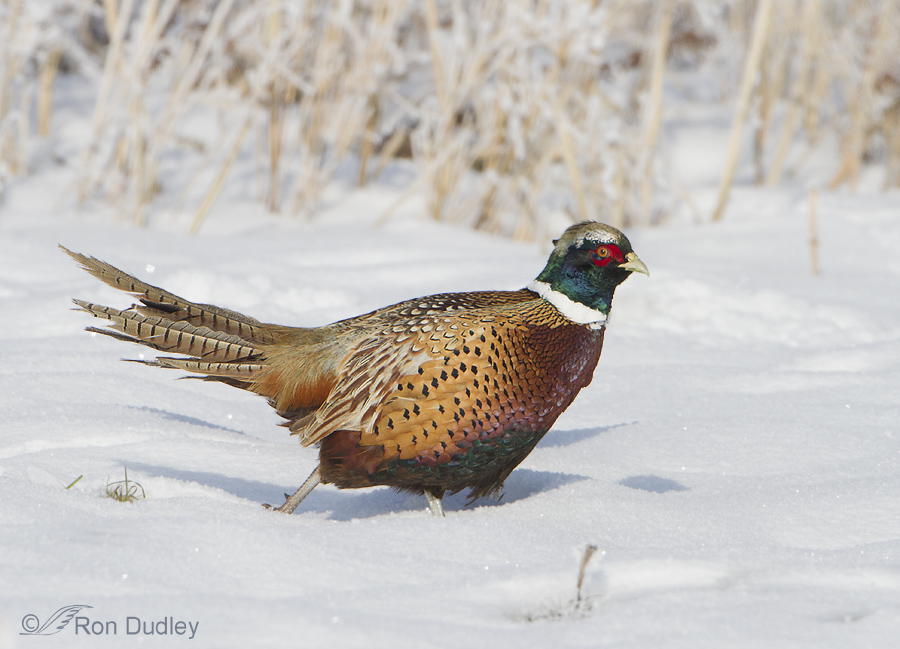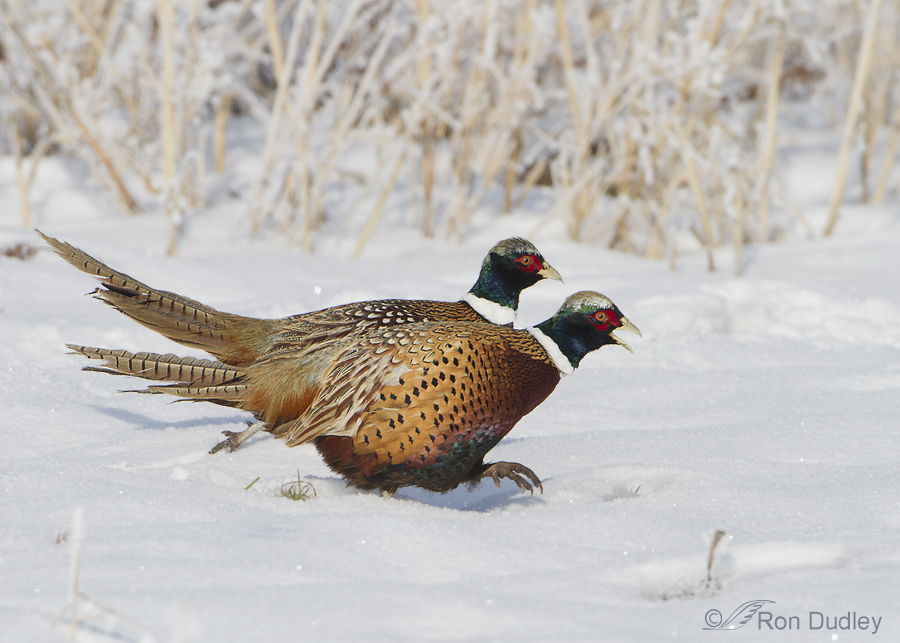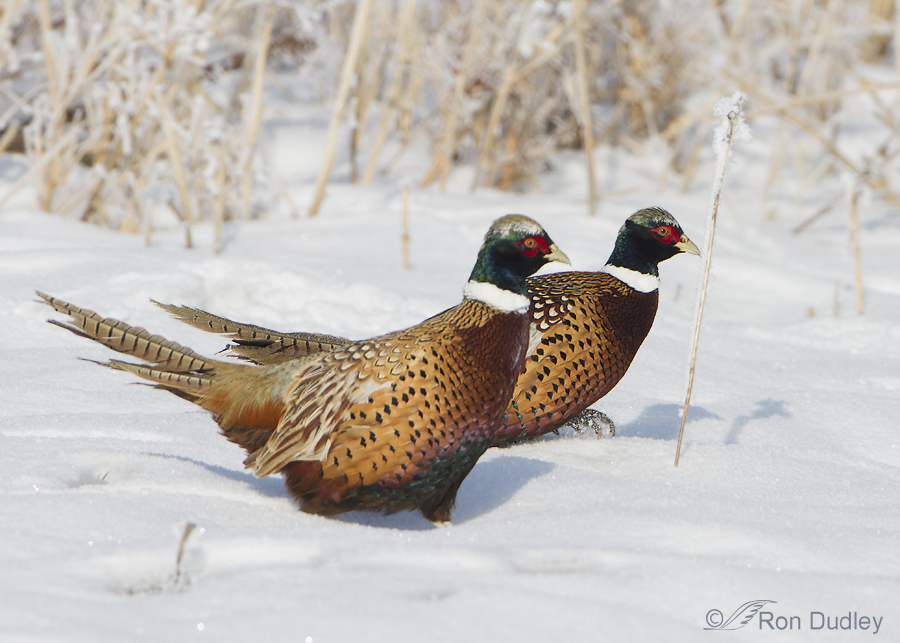Yesterday morning I was able to catch a few Ring-necked Pheasants out in the open at Farmington Bay. This shot reminded me that things aren’t always as they appear.
1/1250, f/9, ISO 500, 500 f/4, 1.4 tc, not baited, set up or called in
At first glance this looks like a simple image of a pheasant running through the snow but that’s not the case. Look more carefully at the bird and see how long it takes you to figure out what’s really going on…
It’s not a pheasant. It’s two pheasants, one in front of the other. If you’re like me the first “double” your eye might pick up on is the extra tail. Then I noticed the top of the back of the rear bird, then the back of its head which lines up to match the head of the pheasant in front. Even the two neck rings are in perfect position to fool the eye (in fact I think they might be key to doing so). And the feet of the rear bird can’t be seen to give it away. You can see parts of the shadow of the mostly hidden pheasant but my brain didn’t cue into that at first. I’ve done no unusual processing here – nothing cloned in or cloned out. All I did was crop, do a minor exposure adjustment and sharpen the bird(s).
1/1250, f/9, ISO 500, 500 f/4, 1.4 tc, not baited, set up or called in
For a little perspective on the situation, here’s an image of the two birds running in the snow that was taken 4 clicks before the previous one. The far bird was running faster than the one in front…
1/1250, f/9, ISO 500, 500 f/4, 1.4 tc, not baited, set up or called in
and passed it up four frames later.
When I was reviewing these images I knew of course that I had been photographing two birds but when I came to the first image presented here it really threw my brain for a loop for a few seconds until I figured out what really happened to the “phantom” pheasant.
But perhaps your brain is more nimble than mine at interpreting optical illusions…
Ron





Ron, sure beats all those old “Where’s Waldo” pictures from years back. I could always find Waldo but did not realize I was looking at two shadows until I read all of your post. Then I laughed.
Really cool! I’ve been showing everyone.
I wonder what the odds of achieving that are????????
Great shots! Someone is very wise in evading the enemy.
Synchronised running.
And, my brain certainly was fooled. As it so often is.
Thank you for another beautiful series.
My first thought was: that’s a really fat pheasant. After I read the post, my first recognition was the second shadow. Fun pic.
I hate to tell you Ron, but I picked out the two tails and the nubbin of a feather horn on the left side of the head before I read your post. I tend to look at your images before reading your post and try and get a gestault for the images, then read. Yes, I know I probably should read first, but that is just me.
Very nice shots, and great lead in to your topic and title.
Very good eye, Dick!
Ron, I can see why you warned me about today’s post! My brain did not get it at all until I started reading your description of what was in the photo. Then, fortunately, I could easily pick it out. My first thought was, why is he saying this is an illusion? It’s one bird. Oh, well – at least I did not have any trouble once you described it, and for me that is progress.
You seem to enjoy these types of shots, Susan. Good – so do I.
Great Pictures! The first one threw me for a loop too. I had to look at it and read the rest of your post to figure it out! But, these birds are always fast and I find difficult to photograph, so well done!
Thanks, Mavourneen. I keep looking for you “out there” but so far have struck out.
The Ringed-neck Pheasant was introduced from various areas of China as a game bird to North America.
They don’t have snow on their heads but these birds have a golden colored plumage on their tops.
Pheasant’s tails take a serious beating throughout the birds very short life. (Most don’t see more than two years.) We often count the bars and anything over 30 is considered good.
Bill
Bill, I once hit a male pheasant at 65mph with a huge U-Haul truck. It hit the edge of the windshield then bounced off and lodged in the frame of the outside mirror (which broke, of course). When I returned the truck to U-Haul (with bird still in place) I expected to pay for damages but those guys turned out to be fly fishermen and they were so excited to get those beautiful feathers for tying flies that the let me off without charging me.
That’s the ying-yang of life on the highway Ron. For both of you. I have hunted pheasants in several of your states and western Canada and treasure their feathers as I to am an avid flyfisher and tie most all my flys as do many of my friends.
Bill
Very cool Ron. I was even looking for two birds in the first photo and could not see the second one !
Glad I’m not the only one, Ed. I (of course) was looking for two birds too…
Beautiful shots and amazing! Thanks for sharing Ron!
Charlotte
Thanks, Charlotte.
I had to be lead to see the second bird…even then it was triicky. Do they have snow in their heads? As I understand it, they were introduced from Japan for “sportsman” to shoot. Ins this true? I notice they are both males…did you see any females?
Patty, no snow on their heads – that’s their natural color there. Yes, this species was introduced from Asia as a game bird. I often see females out there but only saw these two males this time.
This is so great! What are the chances to get a shot like that? I could tell something was odd about the picture but I couldn’t figure it out! What a great way to start my day.
I thought it was a pretty unusual shot too, Marya. Thanks.
Holy pheassant Ron!!! I did not see two either! But what an interesting shot. I thought I saw a second beak sticking up. I wasn’t sure about the tail feathers since I really don’t know what their tail feathers look like. I always just love, love, love the clarity of your photos. This was a really fun series. My brain is definetly not more nimble than yours!!!
Ellen, these tail feathers are actually somewhat shorter than those of many breeding males. I suspect that these two are first year birds. Thank you.
Thanks Ron. I always learn so much
From you!! Your site is the first place I go to every morning. Now I can look at the first photo and see both birds. Guess my brain is working again!!